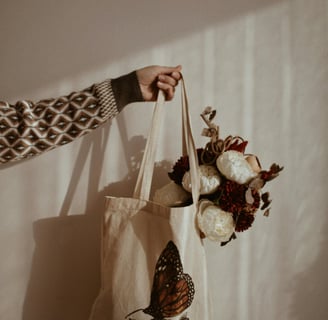Sustainable Art Practices: Eco-Friendly Materials and Techniques
Art and anomaly explores how artists can create impactful work while minimizing the environmental footprint. This article highlights various eco-friendly materials, such as recycled papers, non-toxic paints, and sustainable fabrics, along with innovative techniques that promote sustainability in the creative process. It also emphasizes the importance of reducing waste and making conscious choices that benefit both the artist and the planet. Ideal for environmentally conscious artists and art enthusiasts, this guide offers practical tips for integrating sustainability into artistic practices.
10/16/20243 min read


In an age where environmental awareness is more critical than ever, artists are increasingly seeking ways to create meaningful work while minimizing their ecological impact. Sustainable art practices not only promote environmental stewardship but also inspire creativity and innovation. This article explores eco-friendly materials and techniques that artists can incorporate into their work, highlighting the importance of sustainability in the art world.
1. Understanding Sustainable Art
Sustainable art refers to artistic practices that prioritize environmental health and resource conservation. This can encompass a variety of approaches, from using recycled materials to adopting non-toxic methods and reducing waste. Artists can significantly impact the planet by making conscious choices throughout their creative process.
2. Eco-Friendly Materials
Using eco-friendly materials is one of the most effective ways for artists to embrace sustainability. Here are some popular options:
Recycled and Upcycled Materials
Recycling and upcycling involve repurposing existing materials into new artworks. This practice not only reduces waste but also adds unique character to pieces. Artists can use items such as:
Recycled Paper: Opt for paper made from post-consumer waste, which reduces the demand for virgin materials.
Upcycled Fabrics: Repurpose old clothing or fabric scraps for textile art, quilting, or mixed media projects.
Found Objects: Collect discarded items, such as bottle caps, wood scraps, or metal pieces, to create sculptures or assemblages.
Non-Toxic Paints and Inks
Traditional art supplies often contain harmful chemicals that can be detrimental to both artists and the environment. Fortunately, many brands now offer non-toxic and eco-friendly alternatives:
Plant-Based Paints: Look for paints made from natural ingredients, such as soy, vegetable oils, or minerals. Brands like Eco-House and BioColor offer non-toxic paints that are safe for artists and the planet.
Water-Based Inks: For printmaking, choose water-based inks that have a lower environmental impact compared to solvent-based options.
Sustainable Canvas and Paper
When selecting surfaces for painting or drawing, consider the following eco-friendly options:
Organic Cotton Canvas: Made from sustainably sourced cotton, organic canvas is a great alternative to conventional canvas, which may involve harmful chemicals.
Recycled Paper: Many companies produce high-quality papers made from recycled content, reducing the need for virgin pulp.
3. Eco-Conscious Techniques
In addition to using eco-friendly materials, artists can adopt sustainable techniques that minimize waste and energy consumption:
Minimalist Approach
Embracing a minimalist philosophy can lead to more thoughtful, intentional art-making. By focusing on simplicity and clarity, artists can create impactful pieces while reducing the number of materials used. This approach encourages creativity within limitations and can lead to innovative solutions.
Batch Production
When creating multiple pieces, consider batch production techniques to minimize waste. For example, if you're painting a series, set up your workspace to create all pieces simultaneously. This not only saves materials but also streamlines your workflow.
Natural Dyes and Pigments
Using natural dyes and pigments derived from plants, minerals, and earth can create beautiful, sustainable colors for your art. Experimenting with items like beet juice, turmeric, or indigo can yield unique results while reducing reliance on synthetic dyes.
4. Waste Reduction Strategies
Reducing waste is a critical component of sustainable art practices. Here are some strategies to consider:
Plan Your Projects
Before starting a project, take time to plan your materials and techniques. This can help reduce excess waste and ensure that you use only what you need.
Recycling and Composting
Establish a recycling system in your studio for materials like paper, plastics, and metals. Additionally, compost organic waste from your artistic processes, such as scraps from natural dyes.
Sharing and Collaborating
Engage with your local art community to share excess materials, tools, or supplies. Collaboration with other artists can lead to innovative projects and reduce individual waste.
5. The Importance of Sustainable Art
Sustainable art practices not only benefit the environment but also foster a sense of responsibility among artists and their audiences. By choosing eco-friendly materials and techniques, artists can inspire others to consider their ecological footprint and promote a culture of sustainability within the art community.
6. Conclusion
As the art world continues to evolve, embracing sustainable practices is essential for ensuring a healthy planet for future generations. By incorporating eco-friendly materials, adopting innovative techniques, and reducing waste, artists can create meaningful work that reflects their values and contributes positively to the environment. Ultimately, sustainable art practices enrich the creative process and inspire a deeper connection between artists, their work, and the world around them. Whether you're a seasoned artist or just starting, there are countless ways to make your artistic practice more sustainable. Let your creativity flourish while caring for our planet!
Creativity
Explore art, learn, and embrace your passion.
CONTACT US:
Expression
artandanomaly@gmail.com
© 2024. All rights reserved.
